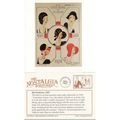Animal - Red Panda - Zoological Society of London postrcard c.1970s
- Condition : Used
- Dispatch : 2 Days
- Brand : None
- ID# : 125000373
- Quantity : 1 item
- Views : 471
- Location : United Kingdom

- Seller : justthebook (+1704)
- Barcode : None
- Start : Fri 28 Feb 2014 05:16:08 (EDT)
- Close : Run Until Sold
- Remain : Run Until Sold
Checks/Cheques
 for 1 item(s) edit
for 1 item(s) edit
Shipping Calculator
More Listings from This Seller view all
Seller's Description
- Postcard
- Picture / Image: Red Panda - photo by M. Lyster
- Publisher: The Zoological Society of London, London Zoo, c.1970s
- Postally used: no
- Stamp: n/a
- Postmark(s): n/a
- Sent to: n/a
- Notes / condition:
Please ask if you need any other information and I will do the best I can to answer.
Image may be low res for illustrative purposes - if you need a higher definition image then please contact me and I may be able to send one.
------------------------------------------------
Postage & Packing:
UK (incl. IOM, CI & BFPO): 99p
Europe: £1.60
Rest of world (inc. USA etc): £2.75
No additional charges for more than one postcard. You can buy as many postcards from me as you like and you will just pay the fee above once. (If buying postcards with other things such as books, please contact or wait for invoice before paying).
Payment Methods:
UK - PayPal, Cheque (from UK bank) or postal order
Outside UK: PayPal ONLY (unless otherwise stated) please. NO non-UK currency checks or money orders (sorry).
NOTE: All postcards are sent in brand new stiffened envelopes which I have bought for the task. These are specially made to protect postcards and you may be able to re-use them. In addition there are other costs to sending so the above charge is not just for the stamp!
I will give a full refund if you are not fully satisfied with the postcard.
----------------------------------------------
Text from the free encyclopedia WIKIPEDIA may appear below to give a little background information (internal links may not work) :
*************
The red panda (Ailurus fulgens), also called lesser panda and red cat-bear, is a small arboreal mammal native to the eastern Himalayas and southwestern China that has been classified as Vulnerable by IUCN as its wild population is estimated at less than 10,000 mature individuals. The population continues to decline and is threatened by habitat loss and fragmentation, poaching, and inbreeding depression, although red pandas are protected by national laws in their range countries.[2]
The red panda is slightly larger than a domestic cat. It has reddish-brown fur, a long, shaggy tail, and a waddling gait due to its shorter front legs. It feeds mainly on bamboo, but is omnivorous and also eats eggs, birds, insects, and small mammals. It is a solitary animal, mainly active from dusk to dawn, and is largely sedentary during the day.
The red panda is the only living species of the genus Ailurus and the family Ailuridae. It has been previously placed in the raccoon and bear families, but results of phylogenetic research indicate strong support for its taxonomic classification in its own family Ailuridae, which along with the weasel family is part of the superfamily Musteloidea.[3] Two subspecies are recognized.[1] It is not closely related to the giant panda.
The head and body length of red pandas measures 50 to 64 cm (20 to 25 in), and their tail is 28 to 59 cm (11 to 23 in). Males weigh 3.7 to 6.2 kg (8.2 to 14 lb) and females 3 to 6.0 kg (6.6 to 13.2 lb).[4][5][6] They have long, soft reddish-brown fur on the upper parts, blackish fur on the lower parts, and a light face with tear markings and robust cranial-dental features. The light face has white badges similar to those of a raccoon, but each individual can have distinctive markings. Their roundish head has medium-sized upright ears, a black nose, and very dark eyes: almost pitch black. Their long bushy tail with six alternating yellowish red transverse ochre rings provides balance and excellent camouflage against its habitat of moss- and lichen-covered trees. The legs are black and short with thick fur on the soles of the paws. This fur serves as thermal insulation on snow-covered or ice surfaces and conceals scent glands which are also present on the anus.[7]
The red panda is specialized as a bamboo feeder with strong, curved and sharp semi-retractile claws[4] standing inward for grasping of narrow tree branches, leaves and fruit. Like the giant panda, it has a “false thumb” that is an extension of the wrist bone. When descending a tree headfirst, the red panda rotates its ankle to control its descent, one of the few climbing species to do so.[8]
The red panda is endemic to the temperate forests of the Himalayas, and ranges from the foothills of western Nepal to China in the east.[9] Its easternmost limit is the Qinling Mountains of the Shaanxi Province in China. Its range includes southern Tibet, Sikkim and Assam in India, Bhutan, the northern mountains of Burma, and in southwestern China, in the Hengduan Mountains of Sichuan and the Gongshan Mountains in Yunnan. It may also live in southwest Tibet and northern Arunachal Pradesh, but this has not been documented. Locations with the highest density of red pandas include an area in the Himalayas that has been proposed as having been a refuge for a variety of endemic species in the Pleistocene. The distribution range of the red panda should be considered disjunct, rather than continuous.[4] A disjunct population inhabits the Meghalaya Plateau of northeastern India.[10]
During a survey in the 1970s, signs of red pandas were found in Nepal's Dhorpatan Hunting Reserve.[11] Their presence was confirmed in spring 2007 when four red pandas were sighted at elevations ranging from 3,220 to 3,610 m (10,560 to 11,840 ft).[12] The species' westernmost limit is in Rara National Park located farther west of the Dhorpatan Hunting Reserve.[13] Their presence was confirmed in 2008.[14]
The red panda lives between 2,200 and 4,800 meters (7,200 and 15,700 ft) altitude, inhabiting areas of moderate temperature between 10 and 25 °C (50 and 77 °F) with little annual change. It prefers mountainous mixed deciduous and conifer forests, especially with old trees and dense understories of bamboo.[4][9]
The effective population size of the Sichuan population is larger and more stable than that of the Yunnan population, implying a southward expansion from Sichuan to Yunnan.[15]
The red panda has become extirpated from the Chinese provinces of Guizhou, Gansu, Shaanxi and Qinghai.[16]
type=printed postcards
theme=animals
sub-theme=red panda
number of items=single
period=1945 - present
postage condition=unposted
Listing Information
| Listing Type | Gallery Listing |
| Listing ID# | 125000373 |
| Start Time | Fri 28 Feb 2014 05:16:08 (EDT) |
| Close Time | Run Until Sold |
| Starting Bid | Fixed Price (no bidding) |
| Item Condition | Used |
| Bids | 0 |
| Views | 471 |
| Dispatch Time | 2 Days |
| Quantity | 1 |
| Location | United Kingdom |
| Auto Extend | No |





















